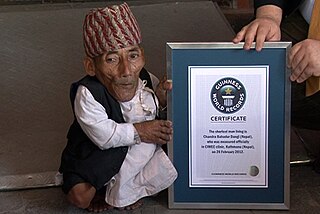 W
WHuman height or stature is the distance from the bottom of the feet to the top of the head in a human body, standing erect. It is measured using a stadiometer, usually in centimetres when using the metric system, or feet and inches when using United States customary units or the imperial system.
 W
WBelow are average adult human heights by country or geographical region. The original studies and sources should be consulted for details on methodology and the exact populations measured, surveyed, or considered.
 W
WA bantam, in British Army usage, was a soldier of below the British Army's minimum regulation height of 5 ft 3 in (160 cm).
 W
WBody mass index (BMI) is a value derived from the mass (weight) and height of a person. The BMI is defined as the body mass divided by the square of the body height, and is expressed in units of kg/m2, resulting from mass in kilograms and height in metres.
 W
WA Body Shape Index (ABSI) or simply body shape index (BSI) is a metric for assessing the health implications of a given human body height, mass and waist circumference (WC). The inclusion of WC is believed to make the BSI a better indicator of risk of mortality from excess weight than the standard body mass index. ABSI correlates only slightly with height, weight and BMI, indicating that it is independent of other anthropometric variables in predicting mortality.
 W
WDwarfism occurs when an organism is exceptionally small. In humans, it is sometimes defined as an adult height of less than 147 centimetres, regardless of sex; the average adult height among people with dwarfism is 122 centimetres, although some individuals with dwarfism are slightly taller. Disproportionate dwarfism is characterized by either short limbs or a short torso. In cases of proportionate dwarfism, both the limbs and torso are unusually small. Intelligence is usually normal, and most have a nearly normal life expectancy. People with dwarfism can usually bear children, though there are additional risks to the mother and child dependent upon the underlying condition.
 W
W"Giant of Castelnau" refers to three bone fragments discovered by Georges Vacher de Lapouge in 1890 in the sediment used to cover a Bronze Age burial tumulus, and dating possibly back to the Neolithic. According to de Lapouge, the fossil bones may belong to one of the largest humans known to have existed. He estimated from the bone size that the human may have been about 3.50 m tall. No modern peer-reviewed study has been published about the alleged giant bone fragments.
 W
WGigantism, also known as giantism, is a condition characterized by excessive growth and height significantly above average. In humans, this condition is caused by over-production of growth hormone in childhood, resulting in people 2.1 to 2.7 m in height.
 W
WThis list includes the shortest ever verified people in their lifetime or profession. The entries below are broken down into different categories which range from sex, to age group and occupations. Most of the sourcing is done by Guinness World Records which in the last decade has added new categories for "mobile" and "non-mobile" men and women. The world's shortest verified man is Chandra Bahadur Dangi, while for women Pauline Musters holds the record.
 W
WMidget is a term for a person of unusually short stature that is considered by some to be pejorative. While not a medical term, it has been applied to persons of unusually short stature, often with dwarfism, a medical condition with a number of causes including achondroplasia, and particularly proportionate dwarfism. The word has a history of association with the performance arts as little people were often employed by acts in the circus, vaudeville, etc.
 W
WThe National Organization of Short Statured Adults (NOSSA) was an American non-profit advocacy group for adults of short stature. The organization clearly defined "short stature" to be men 170 cm (5'7") or below and women 157.5 cm (5'2") or below in height. The group advocated on behalf of short people and hoped to foster greater acceptance of short people within society. NOSSA was opposed to the prejudice known as heightism. The group defined heightism as, "a prejudiced attitude about human height that often results in discrimination. It is based on the belief that short stature is an inferior trait and therefore undesirable." The organization ran a series of public education programs, sponsored height-related research, acted as a media "watch-dog" group, provided legal assistance for those affected by heightism, hosted online discussion groups, and invited members to gather once a year for an annual convention. NOSSA ended in early 2013 due to lack of support.
 W
WParastremmatic dwarfism is a rare bone disease that features severe dwarfism, thoracic kyphosis, a distortion and twisting of the limbs, contractures of the large joints, malformations of the vertebrae and pelvis, and incontinence. The disease was first reported in 1970 by Leonard Langer and associates; they used the term parastremmatic from the Greek parastremma, or distorted limbs, to describe it. On X-rays, the disease is distinguished by a "flocky" or lace-like appearance to the bones. The disease is congenital, which means it is apparent at birth. It is caused by a mutation in the TRPV4 gene, located on chromosome 12 in humans. The disease is inherited in an autosomal dominant manner.
 W
WIn anthropology, pygmy peoples are ethnic groups whose average height is unusually short. The term pygmyism is used to describe the phenotype of endemic short stature for populations in which adult men are on average less than 150 cm tall.
 W
WTall Girl is a 2019 American teen romantic comedy film directed by Nzingha Stewart, from a screenplay by Sam Wolfson. The film stars Ava Michelle, Griffin Gluck, Sabrina Carpenter, Paris Berelc, Luke Eisner, Clara Wilsey, Anjelika Washington, Rico Paris, Angela Kinsey, and Steve Zahn. It was released by Netflix on September 13, 2019.
 W
W"Tall, dark, and handsome" is a phrase that refers to an appealing man, often found in romantic fiction aimed at women.
 W
WA record of the heights of the presidents of the United States and presidential candidates is useful for evaluating what role, if any, height plays in presidential elections. Some observers have noted that the taller of the two major-party candidates tends to prevail, and argue this is due to the public's preference for taller candidates.